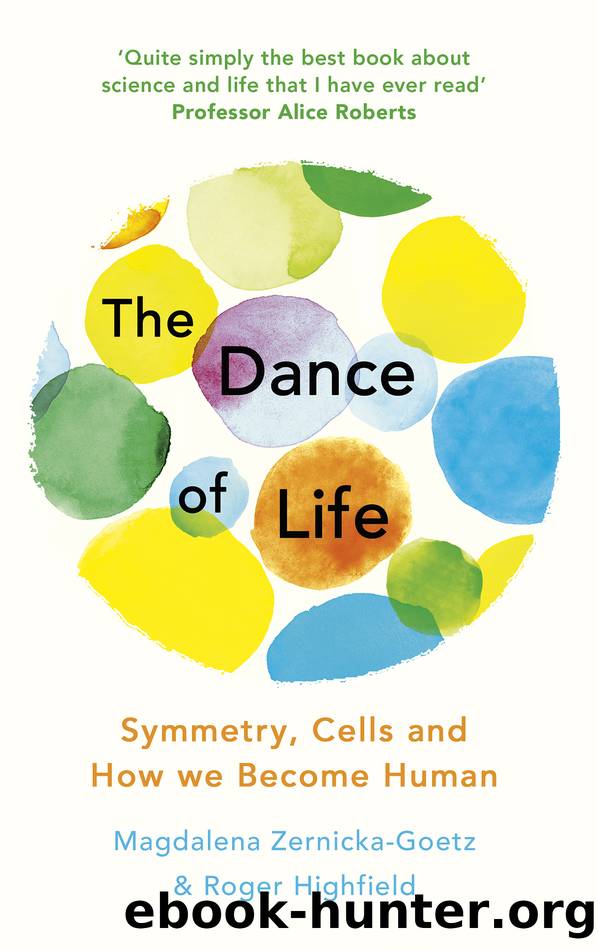The Dance of Life by Magdalena Zernicka-Goetz & Roger Highfield

Author:Magdalena Zernicka-Goetz & Roger Highfield [Zernicka-Goetz, Magdalena & Highfield, Roger]
Language: eng
Format: epub
ISBN: 9780753552940
Publisher: Ebury Publishing
TRISOMY
The best-known example of a chromosomal abnormality involves one of our smallest chromosomes, when children inherit three copies of chromosome 21 instead of the usual two; hence it is called trisomy 21. This particular chromosome carries around two hundred genes, and the resulting shift in the delicate balance of gene products in their cells is what causes Down syndrome.
Most of the time the extra chromosome is a result of abnormal cell division during the development of the sperm cell or the egg cell. Sometimes because of abnormal cell division after fertilization, the affected embryo is a mosaic, a blend of normal cells and cells that contain an extra copy of a chromosome. There is yet another cause—when a chunk of a chromosome can become attached to another chromosome, before or at conception, a process called translocation.
But the tests I had undergone showed that the cells in my placenta carried an extra copy of chromosome 2, which is the second-largest chromosome, much bigger than chromosome 21. This particular chromosome carries around 1,300 genes that make proteins.
Having an extra copy of this large chromosome meant many more extra genes. If this chromosomal abnormality was present in my developing baby, a spectrum of disorders in growth and development might result—depending on how many and where these abnormal cells were to be allocated. David and I printed out all the relevant papers we could find to work out whether babies with even a fraction of their cells with this specific trisomy could be born at all. We found that they could, but with serious defects. Strangely enough, my love for my unborn baby became even stronger.
Perhaps the abnormality picked up by my CVS could have arisen only in the placental cells, which would mean that the baby would have a very high chance of being entirely normal. If so, it must have appeared very early in development of the placenta because so many of its cells were affected and with the same trisomy. This was the outcome I hoped for, but I couldn’t be sure.
An alternative possibility was that the abnormality appeared in the early embryo before the decision was made among its component cells about which would give rise to the placenta and which to the embryo proper. That would most likely lead to profound problems unless these cells were to be somehow eliminated. But could this happen? Was self-repair really possible? At that time, science did not have the answers.
Understanding the fate of abnormal cells in otherwise normal embryos would be central to understanding the fate of embryos that are mixtures of chromosomally normal and abnormal cells. Aneuploidy and such mosaicism are believed to be responsible for the high rates of early human pregnancy failure after normal conception, and following IVF too. However, the fate of abnormal cells in the developing embryo was not at all clear.
This unexpected CVS result redirected me almost overnight, and I began research in my lab that would address this question. I knew that my results would emerge far too late to help my own pregnancy—science takes time.
Download
This site does not store any files on its server. We only index and link to content provided by other sites. Please contact the content providers to delete copyright contents if any and email us, we'll remove relevant links or contents immediately.
| Cell Biology | Developmental Biology |
| Entomology | Marine Biology |
| Microbiology | Molecular Biology |
| Biostatistics |
Sapiens: A Brief History of Humankind by Yuval Noah Harari(13037)
The Tidewater Tales by John Barth(12026)
Do No Harm Stories of Life, Death and Brain Surgery by Henry Marsh(6332)
Mastermind: How to Think Like Sherlock Holmes by Maria Konnikova(6225)
The Thirst by Nesbo Jo(5778)
Why We Sleep: Unlocking the Power of Sleep and Dreams by Matthew Walker(5637)
Sapiens by Yuval Noah Harari(4528)
Life 3.0: Being Human in the Age of Artificial Intelligence by Tegmark Max(4492)
The Longevity Diet by Valter Longo(4444)
The Rules Do Not Apply by Ariel Levy(3897)
The Immortal Life of Henrietta Lacks by Rebecca Skloot(3820)
The Body: A Guide for Occupants by Bill Bryson(3789)
Why We Sleep by Matthew Walker(3767)
Animal Frequency by Melissa Alvarez(3750)
Yoga Anatomy by Kaminoff Leslie(3696)
Barron's AP Biology by Goldberg M.S. Deborah T(3628)
The Hacking of the American Mind by Robert H. Lustig(3575)
All Creatures Great and Small by James Herriot(3506)
Yoga Anatomy by Leslie Kaminoff & Amy Matthews(3392)
